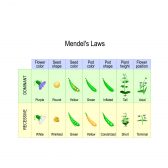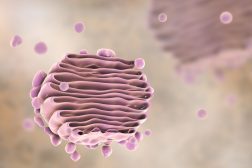Table of Contents
Definition
noun
plural: ribosomal ribonucleic acids
ri•bo•so•mal ri•bo•nu•cle•ic ac•id, ˈraɪ bəˌsoʊ’məl raɪboʊnjuːkliːɪk ˈæsɪd
The ribonucleic acid component of the ribosome
Details
Overview
Ribonucleic acid (RNA) is a nucleic acid, which similar to deoxyribonucleic acid (DNA) is made up of linear chains of monomeric nucleotides. Each nucleotide component, in turn, is made up of phosphoric acid, sugar, and nitrogenous base. RNA differs from DNA in generally being single-stranded and with a ribose sugar component as opposed to DNA’s deoxyribose sugar. Another marked difference is the uracil of RNA in place of thymine in DNA. Thus, adenine complementary base pairs with uracil in RNAs. One of the main functions of RNA is for protein synthesis. There are three major types of RNA involved in this process: (1) messenger RNA (mRNA), (2) transfer RNA (tRNA), and (3) ribosomal RNA (rRNA). Ribosomal RNA is the RNA constituent of the ribosome.
Biological function
Ribosomal ribonucleic acid (rRNA) is a ribonucleic acid that, together with the ribosomal proteins, makes up the ribosome. Ribosomal RNA does not carry the code in making proteins. Rather, it forms the two subunits (i.e. large subunit and small subunit) of a ribosome. The large subunit serves as a ribozyme; it catalyzes the peptide bond formation between two amino acids. The ribosome, in turn, serves as the site of protein synthesis. It has three binding sites: A, P, and E sites. The A site binds to tRNA with an amino acid (called aminoacyl-tRNA). The P site is the site in a ribosome occupied by tRNA carrying the growing peptide chain (i.e. peptidyl tRNA). The E site is the site for decylated tRNA on transit out from the ribosome.1 Using messenger RNA as a template, the ribosome traverses each codon and pair it with a specific amino acid attached to a transfer RNA.
Prokaryotic ribosome vs. Eukaryotic ribosome
Both prokaryotic and eukaryotic ribosomes are made up of two ribosomal subunits. The subunits of the ribosomes are identified by their sedimentation rate represented by Svedberg unit (S). The prokaryotic ribosome (70S) is made up of 50S (large subunit) and 30S (small subunit). The eukaryotic ribosome (80S) consists of 60S (large subunit) and 40S (small subunit). N.B. the S units do not add up since they represent measures of sedimentation rate, not mass. In prokaryotes, the 30S ribosomal subunit contains the 16S rRNA whereas the 50S ribosomal subunit contains 5S rRNA and 23S rRNA. In mammals, the 40S ribosomal subunit contains the 18S rRNA whereas the 60S ribosomal subunit contains rRNAs: 5S, 5.8S, and 28S.
Prokaryotic vs Eukaryotic Ribosomes
| Prokaryotes | Eukaryotes | |
| Ribosomes | 70S
| 80S
|
Prokaryotic Ribosome
| Prokaryote: E. coli2 | |||
|---|---|---|---|
| Ribosome | Subunit | rRNAs | Ribosomal proteins |
| 70S | 50S | 23S | 31 |
| 5S | |||
| 30S | 16S | 21 | |
Eukaryotic Ribosome
| Eukaryote: R. norvegicus2 | |||
|---|---|---|---|
| Ribosome | Subunit | rRNAs | Ribosomal proteins |
| 80S | 60S | 28S | 49 |
| 5.8S | |||
| 5S | |||
| 40S | 18S | 33 | |
Location of rRNAs
Prokaryotic rRNAs are located in the cytoplasm whereas eukaryotic rRNAs are located in cytoplasm (in ribosomes), nucleus, mitochondria, and chloroplast. In mammalian cells, there are four cytoplasmic rRNAs (i.e. 28S, 5.8S, 18S, and 5S) and two mitochondrial rRNAs (i.e. 12S and 16S).
Common biological reactions
Common biological reactions
In eukaryotes, rRNAs are synthesized chiefly in the nucleolus. In mammals, 18S, 28S, and 5.8S rRNA genes in the nucleolus organizer region are transcribed into a pre-rRNA (referred to specifically as 45S pre-RNA) by RNA polymerase I. The result is a large pre-rRNA made up of 18S, 28S, and 5.8S. After processing, they are released individually. As for the 5S rRNA, the genes encoding for it are transcribed into pre-5S rRNA by the RNA polymerase III outside the nucleolus. To form the large subunit (i.e. 60S) of the ribosomal complex, 5S rRNA combines with 28S and 5.8S rRNA. 18S, in turn, forms the small subunit (i.e. 40S) by combining with the ribosomal proteins.
Common biological reactions
Ribosome biogenesis is the process of ribosome synthesis that occurs in the cytosol. In mammals, including humans, ribosome forms by the assembly of 60S and 40S rRNAs. However, 60S and 40S constituents form inside the nucleus, chiefly in the nucleolus. The ribosomal proteins are synthesized in the cytoplasm but are transported into the nucleus to combine with rRNA subunits. They, then, move from the nucleus into the cytoplasm for ribosomal complex assembly in the cytosol.
Biological importance
rRNAs are essential as constituents of ribosomes, the site of protein synthesis. Apart from that, rRNAs are important in evolutionary and taxonomic researches. They may also be used as target in medicine. Some of the antibiotics such as erythromycin, streptomycin, and ricin are designed to disrupt rRNAs of pathogenic microbes.
rRNA vs. rDNA
rRNAs pertain to the nucleic acids in the ribosomes. rDNAs should not be construed as another type of nucleic acid present in the ribosome. The term rDNA is used to refer to the gene clusters that encode for the rRNAs. rRNAs are used as basis in taxonomy and evolution. rDNAs, which are the genes coding for ribosomal RNAs, are sequenced in order to identify the taxonomic group of an organism as well as estimate the rate of species divergence.
Supplementary
Abbreviation(s)
- rRNA
- ribosomal RNA
Further reading
See also
- ribosomal DNA
- protein
- ribosome
- protein synthesis
Reference
- A-site, P-site and E-site. Retrieved from ://www.nobelprize.org/educational/medicine/dna/a/translation/epa.html Link
- Garrett, R. & Grisham, C.M. (2009). Biochemistry (International Student Edition). Cengage Learning Services. ISBN 978-0-495-11464-2; p. 962, 965.
© Biology Online. Content provided and moderated by Biology Online Editors







